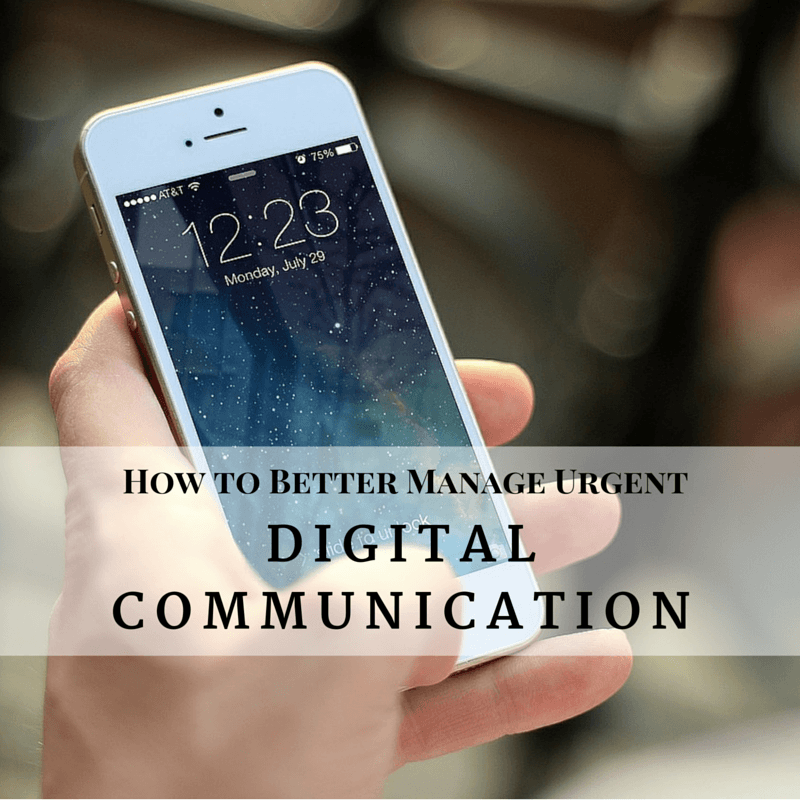
The communications challenge
On average, 204 billion emails, 500 million tweets and 55 million Facebook updates are sent every day.
Our world has become centered around immediate communication and response. Often in 140 characters or less.
With 2.9 devices per person*, we have more ways to communicate than we do people to communicate with. Somehow, with all this technology, we’re communicating more and saying less.
The shift in communications style with the introduction of email meant we could be more casual. Less thoughtful. Hey, it’s email. No worries about the time it takes to type a message out, the cost of postage, or the delay in delivery.
Communications quickly became instantaneous within companies or between friends and family.
The risk with instantaneous communication
With social media, communications are now immediate around the globe. Not only can we share something quickly, it can go viral overnight. Any content.
With such speed of communicating, we expect our needs will be addressed as rapidly. Have a complaint? Post it on Twitter and time the response. It’s quite a change from comment cards or phone calls to a service line.
Not only do we expect, and often receive immediate consideration, the world is watching.
In this age of immediacy, with no immunity to the global visibility of our communications (Hillary’s personal email server isn’t personal anymore), maybe it’s time to slow down.
The fundamentals of the “Slow Down” plan
It’s time to give ourselves the space we need to be thoughtful and purposeful in our communications, instead of fire and forget. Because today, the world may not let us forget.
While our delivery has changed, the risks associated with our responses have not. If we are too quick to respond verbally, without allowing ourselves the time and space to be thoughtful, we can step in doo doo in our interpersonal communications.
Twitter, facebook and email allow the same if we do not pause and reflect before we hit send. Don’t let the recall or edit button fool you. Once it’s in the ether, it can last forever.
What are we to do? Resist the urge. Our smartphones are a tool. They do not control us, unless we let them. While we have the ability to provide immediate response, it does not mean we have to. Or should.
What is the alternative? To consider our mindset, the situation we are responding to, and who will be on the receiving end of the communication.
Responding to Inflammatory Content
No matter who we receive inflammatory content from, there is absolutely no reason to respond right away.
Instead, sleep on it.
Create some distance from the content, allowing for an opportunity to consider the other person’s position from a place of compassion. Responding right away pulls us into whatever negativity the individual is in right now.
If there’s a need to respond sooner, send a response asking until the following day “to ensure I address this thoughtfully.”
Putting a pause on the response will fail to add fuel to the individual’s fire. When the flame is not fed, it means they have to sleep on the message too. It’s possible an apology may be the next contact coming through.
Frustrated with a Situation or Person
We are all asked to do more with less. We have conflicts and stressors at home and at work.
In our attempts to meet all the demands upon us we can find ourselves frustrated by situations (long lines or traffic) or people (team members, customers or colleagues) around us.
When we are frustrated is the worst time to send a communication. Whether there is tone in email or not, it can be implied by the recipient.
If we are convinced this is the time and electronic communication (vs an in-person discussion) is the way to handle it, let someone else read it before hitting send.
Otherwise, walk away for at least an hour. If the situation or person still needs to be addressed, write it up and ask someone to read through to ensure it’s not something to be regretted later.
Urgent Request
Our day is clicking away as we planned when we arrived this morning. We’re preparing for our next meeting, when WHAM – in comes a request from our manager.
The temptation is to drop everything and respond. It’s from our manager and we want to make him or her happy, right?
First, did your manager indicate it was urgent? Is there an implication of urgency? For example, a systems outage during working hours.
Managers do not know the specifics of our day. When they send us communications, they expect we will reasonably manage our other commitments to meet theirs. They do not expect us to drop everything and respond right away unless 1.) the situation warrants it OR 2.) they say so.
This should be true of anyone, not only our manager. If we receive a request someone says is urgent, it may be urgent to them, but still needs to be handled relative to the other work on our plate.
Setting appropriate expectations can be done with team members, customers, and even our manager. Receiving a request is not an automatic trigger to drop everything and act now.
Request for Input
We receive a lot of communications throughout the day. It may be tempting to respond to some of them right away to get them off our list of “to dos.”
When we are requested for input, the person making the request is looking for our thoughtful consideration. Not our knee-jerk reaction.
We need to resist the temptation to put our first thoughts down and hit send. Instead, allow some time and space. Put it aside and come back to it when there is time to think through a complete and coherent response.
If we can respond in two seconds, it could be seen as responsive, but will most likely be seen as sloppy. We get paid for quality of thought and delivery, not time to hit send.
There will be times when we are asked for input and we do not have the time to provide a thoughtful response. It’s okay to set appropriate expectations. Let the person know when a thorough response could be provided, and anything sent in the short-term would only be a cursory review.
Control communications so they don’t control you
Even if we receive communications or contact electronically, it does not mean we have to respond the same way. Particularly for inflammatory content, the best thing to do may be to pick up the phone or walk down to their office (again, after a night’s rest).
We do what we practice. If we practice immediate digital response to every digital contact, we will perpetuate our communication challenges. Instead, let’s stop and consider the kind of communication it is, and what our best response may be. In some cases, the best response may be no response.
Do you have tips for taking control of our communications so they don’t control us? I’d love if you could share your thoughts in the comments and keep the conversation going.
* US average








